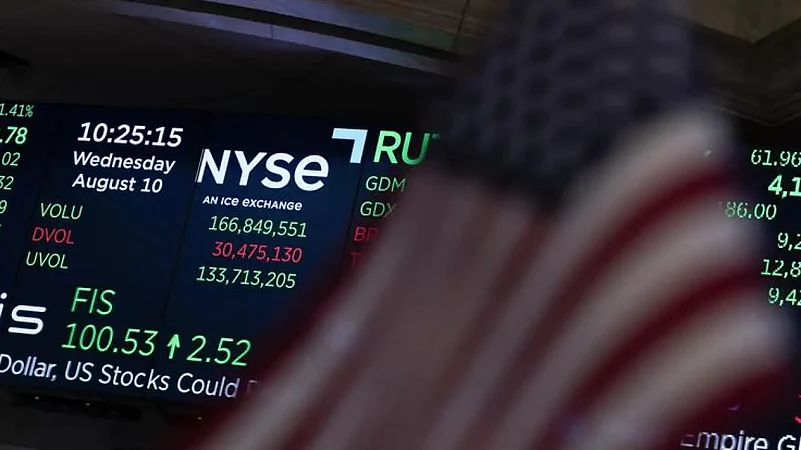The Dow Jones Industrial Average sank more than 1,000 points Friday after the head of the Federal Reserve dashed Wall Street’s hopes that it may soon ease up on high interest rates in its effort to tame inflation.
The S&P 500 lost 3.4%, its biggest drop since mid-June, after Jerome Powell said the Fed will likely need to keep interest rates high enough to slow the economy “for some time” in order to beat back the high inflation sweeping the country.
The Dow dropped 3% and the Nasdaq composite ended 3.9% lower, reflecting a broad sell-off led by technology stocks. Higher rates help corral inflation, but they also hurt asset prices.
Advertisement
The Fed has indicated it will raise rates into next year as it tries to quell demand and bring down prices for goods and services. But some investors speculated the central bank might pause or even reverse course next year if inflation subsides, leading to a rally for stocks in July and early August.
Some analysts expected Powell to bat down that talk in Friday’s speech, and he delivered. His speech followed up remarks by several other Fed officials, who also pushed back on speculation the Fed might act less aggressively or even “pivot.”
“He basically said there will be pain and that they won’t stop and can’t stop hiking until inflation moves a lot lower,” said Brian Jacobsen, senior investment strategist at Allspring Global Investments.
Advertisement
Powell acknowledged the increases will hurt U.S. households and businesses, in perhaps an unspoken nod to the potential for a recession. But he also said the pain would be far greater if inflation were allowed to fester and that “we must keep at it until the job is done.”
He was speaking at an annual economic symposium in Jackson Hole, Wyoming, which has been the setting for market-moving Fed speeches in the past.
The sell-off capped a week of choppy trading that left major indexes down 4% or more for the week.
All told, the S&P 500 fell 141.46 points to 4,057.66. The benchmark index is now down almost 15% for the year.
The Dow lost 1,008.38 points to close at 32,283.40. The last time the blue-chip average had a 1,000-point drop was in May.
The Nasdaq slid 497.56 points to 12,141.71, its biggest drop since June.
The Russell 2000 index of smaller companies fell 64.81 points, or 3.3%, to finish at 1,899.83.
Stocks are still showing solid gains for the third quarter, with the S&P 500 up more than 7% and the Nasdaq up 10%. Recent earnings reports were better than some analysts had expected, and there are signs that inflation may have peaked although it remains at sharply elevated levels.
Still, Powell’s speech made clear the Fed will accept weaker growth for a while for the sake of getting inflation under control, analysts said.
Advertisement
“Powell reiterated that the Fed is worried about rising prices, and getting inflation under control is emphatically job number one,” said Jeff Klingelhofer, co-head of investments at Thornburg Investment Management.
Perhaps giving some hope to investors, some analysts said Powell seemed to indicate expectations for future inflation aren’t taking off. If that were to happen, it could cause a self-perpetuating cycle that worsens inflation.
A report on Friday said U.S. consumers are expecting 2.9% annual inflation over the long run, which is at the lower end of the 2.9% to 3.1% range seen in the University of Michigan’s survey over the last year.
Advertisement
For now, the debate on Wall Street is whether the Fed will raise short-term rates by either half a percentage point next month, double the usual margin, or by three-quarters of a point. The Fed’s last two hikes have been by 0.75 points, and a slight majority of bets on Wall Street are favoring a third such increase in September, according to CME Group.
A report Friday morning showed that the Fed’s preferred gauge of inflation decelerated last month and wasn’t as bad as many economists expected. It’s a potentially encouraging signal, which may embolden more of Wall Street to say that the worst of inflation has already passed or will soon.
Advertisement
Other data showed that incomes for Americans rose less last month than expected, while consumer spending growth slowed.
Following the reports and Powell’s comments, the two-year Treasury yield rose for much of the day, but slipped by late afternoon to 3.36% from 3.37% late Thursday. It tends to track expectations for Fed action.
The 10-year Treasury yield, which follows expectations for longer-term economic growth and inflation, initially rose then slipped to 3.02% from 3.03% late Thursday.
The Fed has already hiked its key overnight interest rate four times this year in hopes of slowing the worst inflation in decades. The hikes have already hurt the housing industry, where more expensive mortgage rates have slowed activity. But the job market has remained strong, helping to prop up the economy.
Advertisement
Investors got a fresh set of warnings from companies about the persistent impact from inflation and a slowing economy. Computer maker Dell slumped 13.5% after it said weaker demand will hurt revenue. Chipmaker Marvell Technology fell 8.9% after giving investors a disappointing earnings forecast.















 Just one email a week
Just one email a week